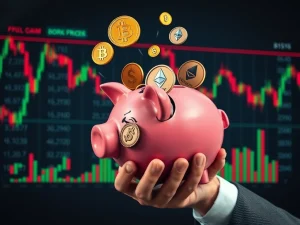Urgent XRP Alert: Negative Funding Rate Sparks Trader Dilemma – Bull or Bear Trap?

Is the recent dip in XRP price a temporary setback or a sign of deeper troubles? The cryptocurrency world is buzzing as the XRP funding rate has flipped negative, sparking intense debate among traders. This rare shift suggests that bearish sentiment is gaining ground, but does it spell doom for XRP, or is it a contrarian indicator signaling a potential buying opportunity? Let’s dive deep into what this negative funding rate means for XRP and how smart traders are positioning themselves in this intriguing market twist.
Decoding XRP’s Negative Funding Rate: A Bearish Omen?
For those new to crypto derivatives, the funding rate is a crucial mechanism in perpetual futures contracts. Think of it as a periodic payment exchanged between buyers (long positions) and sellers (short positions). Its primary purpose is to keep the perpetual contract price anchored to the spot market price.
- When the market is bullish and many traders are longing, the funding rate turns positive. Long traders pay a fee to short traders.
- Conversely, when bearish sentiment dominates and short positions are popular, the funding rate becomes negative. In this scenario, short traders pay a fee to long traders.
Currently, XRP’s 8-hour funding rate has plunged to -0.14%, translating to a weekly cost of 0.3%. This negative funding rate signifies that those betting against XRP are willing to pay a premium for their leveraged positions. Historically, sustained negative funding rates can reflect a lack of confidence in the asset’s immediate price prospects. But is this always a definitive bearish signal?
XRP Price Rut: Is a Deeper Correction Inevitable?
XRP’s price action has been less than stellar recently. Despite the initial excitement following Ripple CEO Brad Garlinghouse’s announcement regarding the SEC clearance on March 19th, which briefly propelled XRP to $2.59, the gains proved fleeting. A sharp 22% correction followed, dragging the price down to $2.02 by March 31st.
Adding to investor unease, XRP is currently trading a significant 39% below its all-time high of $3.40 from January 16th. This price negative performance, coupled with the negative funding rate, is fueling concerns about a potentially deeper correction. However, seasoned traders know that market sentiment can be fickle, and contrarian opportunities often arise when fear is palpable.
Margin Markets vs. Futures: Gauging True Trader Sentiment
While the negative funding rate in futures markets paints a bearish picture, it’s essential to broaden our analysis beyond derivatives. Margin markets offer another valuable perspective on trader sentiment. Unlike futures, margin trading involves borrowing assets to either buy spot XRP (long positions) or sell borrowed XRP (short positions).
Let’s examine the XRP long-to-short margin ratio at OKX, a leading cryptocurrency exchange. This metric reveals the balance between leveraged long and short positions in the margin market. A high ratio indicates strong bullish sentiment, while a low ratio suggests bearish leaning.
Currently, the XRP long-to-short margin ratio at OKX stands at 2x in favor of longs. This is notably low, hovering near its lowest level in over six months. Historically, extreme bullish confidence has pushed this ratio above 40x, while readings below 5x favoring longs are generally interpreted as bearish signals. This low margin ratio reinforces the bearish narrative suggested by the negative funding rate.
Donald Trump Effect: A Glimmer of Hope for XRP?
Despite the bearish signals from both derivatives and margin markets, there are potential catalysts that could shift the tide for XRP. Interestingly, XRP has been gaining mainstream attention, even from unexpected corners. On March 2nd, former US President Donald Trump surprisingly mentioned XRP, alongside Solana (SOL) and Cardano (ADA), as potential candidates for the country’s digital asset strategic reserves.
This unexpected endorsement, even if not a formal policy, significantly boosted XRP’s visibility. Google search trends reflect this surge in interest. For a brief period in early March, search interest for XRP even surpassed that of Bitcoin (BTC). A similar spike in Google searches occurred following Ripple CEO Garlinghouse’s SEC announcement on March 19th. This increased awareness could attract new investors and potentially offset some of the bearish pressure.
Adoption and Liquidity: XRP’s Enduring Strengths
As the third-largest cryptocurrency by market capitalization (excluding stablecoins), XRP benefits from its first-mover advantage and robust liquidity. Its early entry into the crypto space has established a strong network effect and deep market penetration.
Furthermore, traditional financial institutions are increasingly embracing XRP. Interactive Brokers, a global brokerage giant, recently expanded its cryptocurrency offerings to include XRP, alongside SOL, ADA, and DOGE. This wider adoption by established intermediaries lends further legitimacy to XRP and opens it up to a broader investor base.
The combination of rising mainstream awareness, increasing institutional adoption, and XRP’s inherent liquidity could provide a strong foundation for future price gains, especially when macroeconomic conditions improve and retail investors return to altcoins seeking alternatives to traditional finance.
Navigating the XRP Crossroads: Long or Short?
So, back to the initial question: With the negative funding rate and bearish market signals, should smart crypto traders be flipping long or short on XRP? There’s no simple answer, and the optimal strategy depends on individual risk tolerance and trading style.
Arguments for considering a long position (contrarian view):
- Negative funding rate as a potential buy signal: Extreme bearish sentiment, reflected in a deeply negative funding rate, can sometimes precede a trend reversal. Smart traders often look for opportunities to buy when the crowd is fearful.
- Mainstream adoption and awareness: Trump’s mention and increased institutional adoption could be early indicators of renewed interest in XRP.
- XRP’s fundamental strengths: Liquidity and established market presence remain key advantages for XRP.
Arguments for considering a short position (following the trend):
- Bearish signals from funding rate and margin ratio: Both metrics currently point towards significant bearish market sentiment.
- Price correction and uncertainty: XRP is in a clear correction phase, and further downside is possible.
- Macroeconomic headwinds: Broader market uncertainty could exacerbate downward pressure on XRP.
Conclusion: A Calculated Approach to XRP Trading
The current XRP market presents a complex picture. The negative funding rate and bearish margin data cannot be ignored, suggesting caution. However, contrarian signals like increased mainstream attention and institutional adoption offer a glimmer of hope. Smart crypto traders will need to carefully weigh these factors, conduct thorough due diligence, and potentially employ risk management strategies like hedging or position sizing to navigate this uncertain market. Whether you choose to go long or short, remember that in the volatile world of cryptocurrency, informed decisions and adaptability are paramount.
Disclaimer: This article is for general information purposes only and does not constitute investment advice. Cryptocurrency trading involves substantial risk of loss. Conduct your own research and consult with a financial advisor before making any investment decisions.








